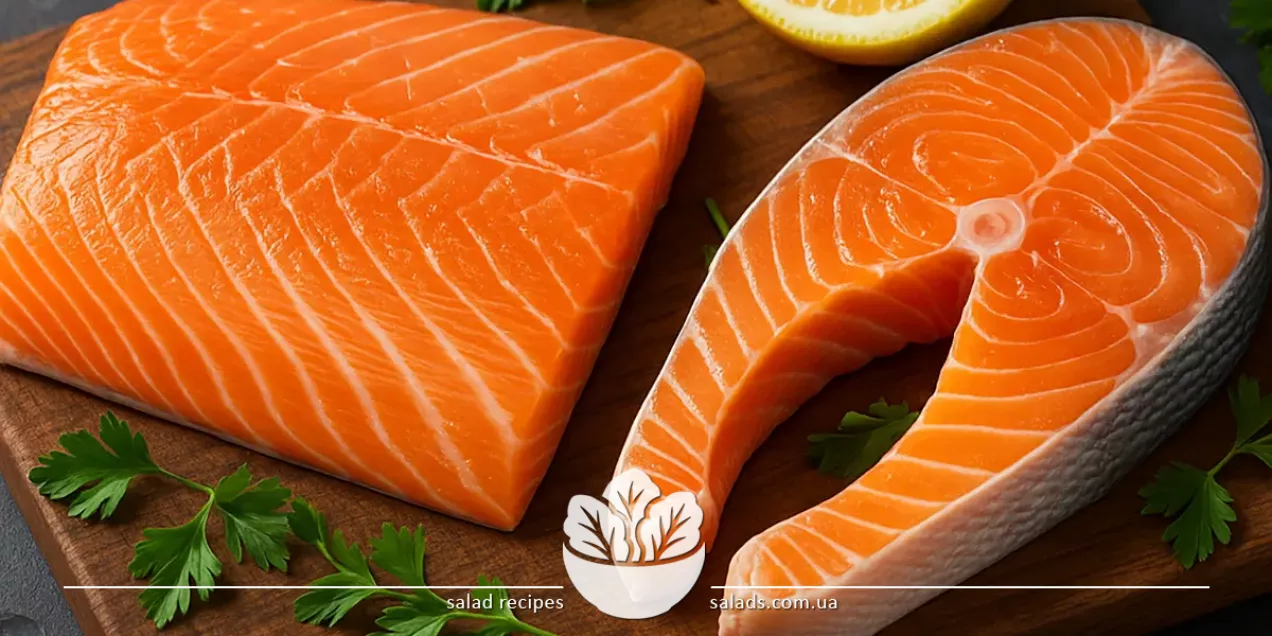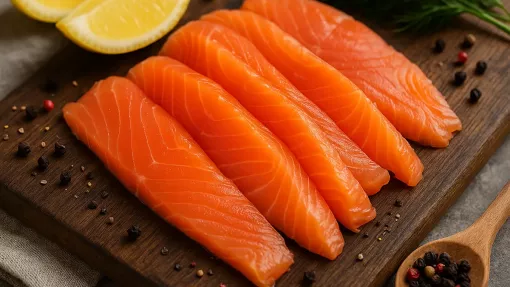Salmon

Salmon is a delicate, nutritious, and highly versatile red fish with a characteristic pink color, smooth texture, and high culinary value. Its flesh is rich in protein, omega-3 fatty acids, and vitamins, and its flavor profile makes it ideal for both everyday meals and restaurant-quality dishes. Within the fish category, salmon holds a leading position due to its combination of gastronomic quality, health benefits, and broad culinary applications.
Different Types of Salmon
Fresh Salmon: A Versatile Ingredient for Everyday and Festive Meals
Fresh salmon is one of the most valued products in modern gastronomy. With its soft texture, moderate fat content, and rich flavor, it is used in a wide range of dishes – from simple meals to refined restaurant offerings. Fresh fillets have an attractive pink or orange hue, require minimal processing, and are well suited to frying, baking, grilling, or steaming. Salmon fillets are often served as steaks or portioned pieces cooked in a pan or oven, accompanied by vegetables, herbs, or sauces based on cream, lemon, or mustard. Bowls featuring seared salmon, vegetables, and rice are also popular in contemporary menus – delicious and nutritious meals suitable for breakfast, lunch, or dinner.
Fresh salmon pairs well with spicy and tangy components – orange, ginger, soy sauce, mint, horseradish. It is also served as tartare or carpaccio – raw, finely chopped, and seasoned with aromatic dressings. In such dishes, product quality is especially important: fresh fillets should be odorless, have a smooth surface, and an elastic structure. Thanks to its high levels of healthy fats and vitamins, fresh salmon is considered one of the most valuable sources of omega-3, which positively impacts cardiovascular health and brain function. It is ideal for those seeking a balance between culinary enjoyment and healthy eating.
Lightly Salted Salmon: A Classic for Appetizers and Breakfast
Lightly salted salmon is one of the most popular ways to enjoy this fish, especially in Northern European countries and modern gastronomy. Its flesh has a rich color, elastic texture, and a characteristic sweet-salty flavor with delicate smoky or citrus notes, depending on the curing method. Thanks to the gentle processing, it retains nearly all the nutrients of fresh fillets and is perfect for cold dishes. Lightly salted salmon is served in thin slices and used in sandwiches, canapés, salads, tartlets, appetizers with cream cheese, and more elaborate dishes. For example, salmon on toast with cream cheese, herbs, and a poached egg is a modern breakfast or brunch staple. As it is ready to eat, the product does not require additional preparation, making it especially convenient.
In gastronomy, lightly salted salmon is associated with sophistication and festivity: it is served at receptions, as part of cold platters, in rolls, on skewers, or as an ingredient in salads with citrus fruits, avocado, and herbs. It pairs well with creamy, fermented milk, and mustard-based sauces, fresh vegetables, and crispy bread. Besides its flavor, this product has high nutritional value: rich in omega-3 fatty acids, protein, and vitamins D, B6, and B12. Regular consumption of lightly salted salmon in moderation supports heart function, vascular health, the nervous system, and skin. It is a true "functional delicacy" that fits easily into any diet.
Baked Salmon: A Classic Choice for Balanced Nutrition
Baked salmon is one of the most popular ways to prepare this fish, combining health benefits, flavor, and simplicity. Thanks to its natural fat content, salmon remains juicy even when baked in the oven, retaining a tender texture and intense aroma. It is often cooked in foil, in creamy sauces, with vegetables, citrus, or aromatic herbs – often without adding extra fat. This method suits everyday meals as well as festive dinners. For example, baked salmon with rosemary, garlic, and apples is a unique yet light dish that blends the saltiness of fish with the subtle sweetness of fruit. In a more traditional version, salmon is baked with lemon, broccoli, and potatoes or with a sauce made from mustard and honey.
The advantage of baked salmon is its suitability for various dietary approaches: it is favored by people on diets, ketogenic plans, athletic meal plans, or those simply aiming for a balanced diet. It pairs well with side dishes of vegetables, grains, legumes, as well as light sauces and dressings based on yogurt, Greek cheese, mustard, or citrus. As a source of quality protein, omega-3 fatty acids, and vitamins D and B12, such dishes positively influence the cardiovascular system, brain, and skin. Regularly including baked salmon in your diet is a simple step toward better health without compromising on taste.
Salmon in Sushi and Rolls: A Fresh Foundation for Refined Dishes
Salmon is one of the key ingredients in Japanese cuisine, especially in sushi, sashimi, and rolls. Thanks to its tender texture, pleasant taste, and high fat content, it is ideal for raw consumption. Its flesh has a vibrant pink color and is easily cut into thin slices while retaining its shape and visual appeal. In sushi, salmon is commonly used in rolls (maki, uramaki), nigiri, sashimi, and gunkan. It pairs well with rice, avocado, cucumber, cream cheese, caviar, and less conventional additions – such as mackerel in double-filled rolls. The mild flavor of salmon allows it to be combined with both classic and experimental ingredients.
For raw consumption, it is essential to use high-quality salmon – chilled and farmed under strict veterinary control. Its meat should be evenly colored, firm, glossy, and free from foreign odors. Before making sashimi or sushi, salmon is often frozen to -20 °C to eliminate potential parasites. In modern gastronomy, salmon in sushi is not just a flavor component but also a visual accent: its rich color and slicing style contribute to presentation. Additionally, it is a source of omega-3, protein, vitamin D, and antioxidants, making these dishes not only appealing but also nutritious. Salmon sushi represents a fusion of simplicity, health, and aesthetics.
Nutritional Value of Salmon: Omega-3, Protein, and Vitamins
Salmon exemplifies a fish that combines high nutritional value with a delicate flavor. A 100 g portion contains about 20 g of complete protein and 10-13 g of fat, primarily in the form of beneficial omega-3 fatty acids. These fats are what make salmon such a valuable dietary component: they support cardiovascular health, lower cholesterol, improve skin condition, and enhance brain function. Besides fats and protein, salmon contains vitamins D, B6, B12, E, and essential micronutrients such as selenium, potassium, phosphorus, magnesium, and zinc. This composition makes regular salmon consumption effective for boosting immunity, balancing hormones, supporting the nervous system, and improving overall well-being. It is recommended for periods of intense physical or mental exertion, in children's diets, and during recovery from illness.
As it is easy to digest, salmon is ideal for everyday meals – whether in hot dishes or cold appetizers. For example, a salad with baked salmon, fresh herbs, and cheese provides protein, healthy fats, and calcium in one serving. Such a dish ensures a lasting feeling of satiety without burdening the body. Salmon is one of the few foods that meet the demands of healthy nutrition, gastronomic refinement, and culinary convenience all at once. It combines easily with most ingredients, adapts to various world cuisines, and remains a reliable source of nutrients in any form of preparation.
